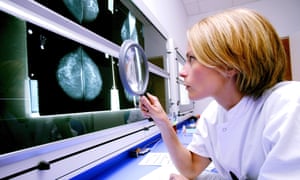Lekarze rodzinni mogą używać kalkulatora raka piersi do przewidywania ryzyka dla kobiet
Kobiety mogą być w stanie udać się do swojego lekarza rodzinnego, aby dowiedzieć się o ryzyku zachorowania na raka piersi i zdecydować, czy poddać się badaniu przesiewowemu, czy nowy internetowy kalkulator raka opracowany przez naukowców odniesie sukces.
Naukowcy z Cancer Research UK opracowali sposób oceny ryzyka zachorowania kobiet na tę chorobę na podstawie danych genetycznych i ryzyka związanego ze stylem życia. Mają nadzieję zaoferować w miarę dobre prognozy, łącząc informacje na temat historii rodziny i genetyki z innymi czynnikami, takimi jak waga, wiek w okresie menopauzy, spożywanie alkoholu i stosowanie hormonalnej terapii zastępczej.

Radiolog bada mammografię na lightboxie za pomocą lupy. Wszyscy kandydaci otrzymają e-mailem wyniki swojej aplikacji: REX/Shutterstock
Znanych jest wiele czynników ryzyka związanych ze stylem życia i rakiem piersi, ale każdy z osobna często nie daje zbyt wiele. Skumulowany efekt, Jednakże, może mieć znacznie większe znaczenie. To samo tyczy się genów. Dwa odziedziczone wadliwe geny – BRCA1 i BRCA2 – zwiększyć ryzyko zachorowania na raka piersi u kobiet. Jednak obecnie uważa się, że istnieje wiele innych genów, które odgrywają niewielką rolę. Badacze, dla ich oceny ryzyka, wzięli pod uwagę 300 różne geny, które można zidentyfikować.
„Po raz pierwszy ktoś połączył tak wiele elementów w jednym narzędziu przewidywania raka piersi,powiedział prof. Antonis Antoniou, główny autor badań na Uniwersytecie w Cambridge.
On dodał: „Może to zmienić zasady gry w przypadku raka piersi, ponieważ teraz możemy zidentyfikować dużą liczbę kobiet o różnym poziomie ryzyka – nie tylko kobiety z grupy wysokiego ryzyka”.
„Powinno to pomóc lekarzom w dostosowaniu zapewnianej opieki do poziomu ryzyka pacjentów. Na przykład, niektóre kobiety mogą potrzebować dodatkowych wizyt u lekarza w celu omówienia badań przesiewowych lub możliwości zapobiegania, a inne mogą po prostu potrzebować porady na temat stylu życia i diety.
„Mamy nadzieję, że dzięki temu więcej osób będzie mogło zostać zdiagnozowanych wcześniej i dłużej przeżyć chorobę, jednak potrzeba więcej badań i prób, zanim w pełni zrozumiemy, jak można to wykorzystać”.
Duża część 55,000 Rak piersi diagnozowany co roku w ramach NHS dotyczył kobiet o podwyższonym ryzyku wystąpienia tej choroby. Jeśli kalkulator działa dobrze, mogłoby to doprowadzić do wcześniejszej identyfikacji większej liczby osób zagrożonych, kiedy można je skutecznie leczyć.
Oznaczałoby to również, że badania przesiewowe w kierunku raka piersi, poprzez mammografię, można było precyzyjniej ukierunkować. Nie wszystkie kobiety chcą poddać się badaniom przesiewowym, obecnie, ze względu na ryzyko błędnej diagnozy raka. Kalkulator może pomóc kobietom w podjęciu decyzji, czy chcą poddać się badaniu przesiewowemu, czy nie.
Źródło: www.opiekuna.com


Zostaw odpowiedź
Musisz Zaloguj sie lub Zarejestruj się dodać nowy komentarz .